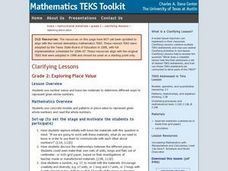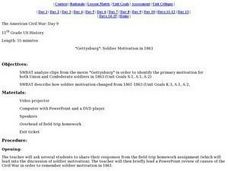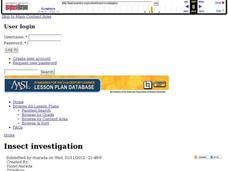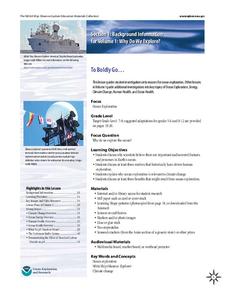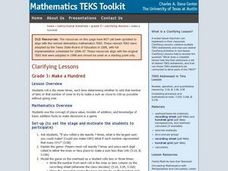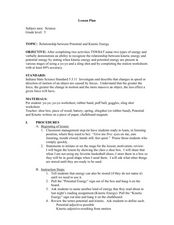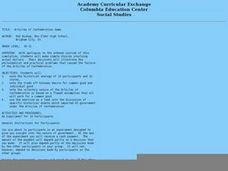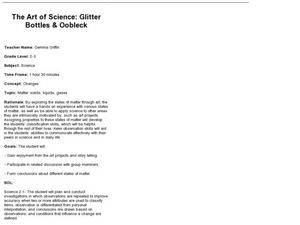Curated OER
Grade 2: Exploring Place Value
Creative problem solving is fun and helps kids conceptualize content. They use grid paper, manilla paper, and markers to cut, draw, and show given double-digit numbers as many ways as they can.
Curated OER
Motivation
Students examine the role of motivation in the workplace. They identify different motivation techniques and analyze the views of motivational thinkers. They apply the knowledge they gathered to different scenerios.
Curated OER
Grade 3: What Can I Make with 30 Centimeters?
Third graders create polygons with perimeters of 30 centimeters, use the centimeter grid paper to determine the area of each shape, and organize the shapes to make generalizations from the patterns they see.
Curated OER
Grade 2: Spinning Sums
Second graders collect data by spinning two spinners and creating sums, organize the data, and make conclusions from the data. Each students makes a spinner. They spin and record the number of the section each time. Students work in...
Curated OER
Grade 2: Roll or Slide?
Second graders organize solids into categories, depending upon whether they will roll, slide or do both on a home made ramp. Students describe and compare attributes of three-dimensional geometric solids.
Curated OER
"Gettysburg": Soldier Motivation in 1863
Eleventh graders watch and discuss various clips from the movie "Gettysburg". Using the video, they identify the main motivation for the Union and Confederate soldiers. They describe how soldiers motivation changed from 1861 and 1863.
Curated OER
Insect Investigation
Investigation is a brilliant way to spark scientific inquiry. First graders will identify, research, and report what they have learned about a mysterious bug found on the playground. They will use multimedia resources for research and...
NOAA
To Boldly Go...
When we think of ocean exploration, many of us have visions of sunken pirate ships full of treasure or mysterious creatures of the deep. What really motivates deep-sea investigation? The first in a series of diverse six-part lessons...
Curated OER
Grade 3: Make a Hundred
Third graders roll a die seven times, each time determining whether to add that number of tens or that number of ones to try to make a sum as close to 100 as possible without going over.
Curated OER
Using Poster Presentations with ESL Students
Students organize ways to present effective poster presentations. Students skill their posters by the majors they have chosen. Students engage in researching how to use their collaboration time in groups effectively.
Curated OER
Grade 5: Multiple Towers
Fifth graders use interlocking cubes to build towers to represent factors of numbers and place the towers in the appropriate places on a Tower chart in order to look for patterns. They work in partner groups, and finish by writing...
Mathematics TEKS Toolkit
Grade 6: Exploring c/d = pi
Introduce your math class to the perimeter of a circle. Teach them that pi describes the relationship between the circumference and the diameter. As a hands-on investigation, pairs or small groups use string to compare these two values...
Curated OER
Solids in the Playground
First graders locate and identify solids in the schoolyard. In this geometric solids lesson, 1st graders locate two solids on the playground. They work as a group to compare and contrast them according to shape, texture, weight, size,...
National Park Service
What Can We Do?
Motivate young conservationists to stand up and make a change. After learning about the efforts in Cascade Nation Park to reduce carbon emissions in order to preserve the wilderness, students work in groups creating action plans for...
Curated OER
Nutrition 2: Good Food, Good Health
Students examine how food provides them with energy and materials for their body. In groups, they identify good and bad foods to maintain a healthy lifestyle. Using the internet, they research how food can affect their overall health.
Curated OER
Relationship between Potential and Kinetic Energy
Fifth graders explore the relationship between potential energy and kinetic energy. In this energy lesson, 5th graders examine objects and describe potential and kinetic energy of the objects. Students complete two worksheets.
Curated OER
Mapping the Aegean Seafloor
Earth science learners create a two-dimensional topographic map of the floor of the Aegean Sea. They use it to then create a three-dimensional model of the ocean floor features. This comprehensive resource delivers strong background...
Curated OER
Articles of Confederation Game
Why did the Articles of Confederation fail? Your historians will find out firsthand through this simulation activity, during which they will use money (consider using extra credit) to demonstrate the inherent flaws. It's simple: each...
Curated OER
Eco-Healthy Lunch
Students plan healthy lunches and how to dispose of their lunch waste. In this pre-field trip lesson plan, students and teachers plan healthy, nutritious lunches to bring on a field trip. They also discuss how to sort their garbage into...
Curated OER
Bubble-ology and Bernoulli
Students explore aerodynamics and Bernoulli's principle by devising ways to keep bubbles aloft.
Curated OER
Science Lesson #2
Fourth graders explore and experiment with objects that float to see if they float differently in salt water or fresh water. After the experiment, they write a paragraph in their science journal explaining how fresh water and ocean water...
Curated OER
The Art of Science: Glitter Bottles and Oobleck
After having a class discussion on the three states of matter, young scientists utilize the wonderful substance, Oobleck in order to experience something that changes states of matter. They also create "sparkle jars" which...
American Statistical Association
A Sweet Task
Candy is always an effective motivator! A fun math activity uses M&M's and Skittles to explore two-way frequency tables and conditional probability. The candy can serve a dual purpose as manipulatives and experimental data.
Curated OER
Rocks and Minerals
Review the difference between rocks and minerals using this resource. Learners identify and investigate the physical properties of these objects. They create a Venn diagram to compare and contrast types of rocks. This is a motivating way...
